A Lancer and Light Horseman
Sergeant Major John McDonald Simons
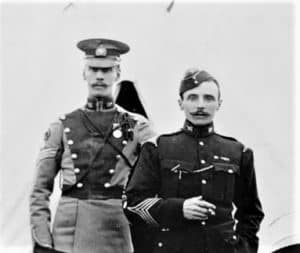
A most interesting group of medals along with a photo album was offered to me about 19 years ago.still feel privileged to have had the opportunity to be a ‘temporary custodian’ of the mementoes of this truly professional soldier, Sergeant Major John McDonald Simons. He saw over twenty years of military service and participated in a very famous action – the charge of the 21st Lancers at Omdurman. This action took place during Kitchener’s campaign in the Sudan in 1898.
While there were no research details with these items, the medals had been left in a family will to a good friend. Because my friend knew the family he was in a position to supply basic information about the soldier. This information provided me with a ‘head start’ and good direction to start my research.
The highlight of all these military items were the photo albums, meticulously kept over the years by an obviously proud and professional soldier. Of the 78 photos, 46 depict his military career in India, Sudan, England, Australia and the Middle East.
From 1890 to 1916 the photos and paintings span 26 years of dedicated service.
John signed up as No. 3096, Private in the 21st Hussars. On 3rd September, 1890 he was posted to India with his Regiment and two years later he was promoted to Lance Corporal. In 1894 he was promoted to full Corporal and two years later was promoted to Lance Sergeant. In October 1896 John ended his six year stay in India when his regiment was posted to the Sudan (in 1897 the 21st Hussars changed their title to 21st Lancers).
Unbeknown to John at this stage, this new posting was to see him participate in a very famous cavalry action. This was of course the charge of the 21st Lancers at Omdurman on 2nd September, 1898 – recognised as one of the last great cavalry charges in modern history (at the charge of Beersheba in Palestine on 31 October, 1917, the Light Horse used their bayonets as they were not armed with cavalry swords or lances).
This fearless charge at Omdurman was to feature in the annals of British military history for decades to come. John McDonald Simons was a Lance Sergeant in ‘D’ Troop at the time of the charge. Records show that ‘D’ Troop had 11 men KIA and 13 WIA, followed by ‘B’ Troop, who suffered 10 men KIA and 24 WIA.
Many accounts have been written about this action but a brief outline would be beneficial to some readers: A British hero, General ‘Chinese’ Gordon, was killed at Khartoum in 1885 during failed British attempts to rescue him and raise the Mahdi’s siege. Eleven years later, General Sir Herbert H. Kitchener, at the head of an Anglo- Egyptian army of 15,000 men went to the Sudan to smash the Mahdi’s ‘Dervishes’ and avenge Gordon’s death.
After many months of hard campaigning, Kitchener arrived at a small village on the banks of the River Nile called El Egeiga. This village was not far from the Khalifa’s palace in Omdurman.
Intelligence reports had informed Kitchener that the Khalifa’s army of approximately 40,000 Dervishes had left the walled city of Omdurman and planned to attack the ‘infidels’ in the desert (some estimated the force to be closer to 60,000 Dervishes).
A ‘zariba’ defence works of mimosa thorn hedges was constructed in a semicircle shape, with the River Nile in the rear of the British and Egyptian troops. Several Royal Navy gunboats were positioned in the river just behind the troops, to offer covering fire should it be required.
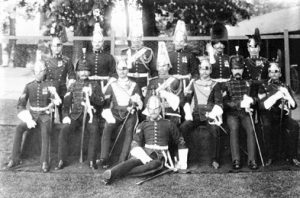
The Dervish attack started at 6.30am on 2nd September 1898. The massed attacks were to continue until 8.30am, with the British and Egyptian troops taking a terrible toll on the fanatical Dervish ranks. The concentrated British fire ensured that the Dervishes never came closer than an estimated 700 yards from the British firing line. The desert was strewn with thousands of dead and dying Dervishes.
As Churchill stated… “discipline and machinery triumphed over the most desperate valour”.
After this enormous carnage on the battlefield, the Dervishes started to withdraw back towards Omdurman.
Kitchener immediately wheeled his five brigades into his usual echelon formation and with his left flank on the river, proceeded to march towards the walled city of Omdurman. The Khalifa’s days were running out!
“Before embarking on an advance into country hidden from view behind a hill, it was an elementary precaution to send ahead the cavalry to look over the top and report on any possible hazards”. The Sidar therefore instructed the 21st Lancers to reconnoitre beyond the Jebel Surgham hills in the direction of Omdurman.
After some distance the 21st Lancers saw a group of about 700 ‘fuzzy-wuzzy’ horsemen. The enemy were drawn up and confronting the English Lancers with the apparent intention of checking their further advance. Colonel Martin ordered the advance and 310 Lancers moved in the direction of the Dervish horsemen. It was the oldest and favourite of tricks in Arab tactics. A deep ‘khor’ (depression) ran behind the Dervish horsemen and – unbeknown to the Lancers, approximately 2000 fresh Dervish troops under Osman Digna’s flag, lay concealed in the depression. The exposed Dervish horsemen opened fire on the Englishmen and the order was given to for the Lancers to “charge”.
The 310 Lancers galloped ahead and as they topped the rise, they beheld thousands of white robed men packed twelve deep in the depression. Even if they had wanted to, the Lancers could hardly have checked their charge in time – they spurred their horses on and in a few seconds, were amongst the massed Dervish ranks, fighting with lance and sword. The Dervishes fought back fanatically and ferociously, attacking the Lancers and their horses with Remington rifles, spears and their broad bladed swords.
The Lancers speared, chopped, slashed and battered their way through and emerged on the far side of the Dervish position. In less than two minutes 21 of the Lancers were dead and approximately 65 seriously wounded. Over a quarter of their poor horses were either killed or maimed. The Lancers regrouped, galloped around to the Dervish flank, dismounted and opened an accurate fire on the advancing horde of black men. The charge had however shaken the Dervishes and in the face of accurate .303 magazine Lee-Metford carbine fire, they withdrew.
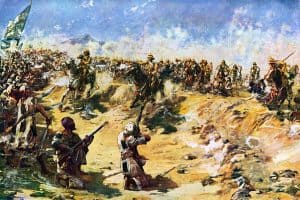
Suffice to say that Lance Sgt. John McDonald Simons must have seen his fair share of action that day!
A certain young war correspondent, Lieutenant Winston S. Churchill was attached to the 21st Lancers and also took part in the charge.
At the end of the days fighting on the bank of the River Nile, an estimated ten to eleven thousand Dervishes were dead on the field – for a loss of 500 British and Egyptian casualties.
As a result of their famous charge, the 21st Lancers became well known and were favoured by Her Majesty Queen Victoria with the title 21st “Empress of India’s” Lancers.
After three years in Egypt and the Sudan, John was posted back to England on 11th November 1899 – the Boer War was but a month old. John was promoted to the rank of Sergeant in January 1900 and remained in England for the duration of the Boer War. John’s next promotion was to Squadron Sergeant Major in June 1904. In April 1906 he was transferred to the City of London Imperial Yeomanry (Rough Riders) as a permanent staff instructor. He remained in this position until his discharge to pension on 2nd January, 1909. His age at discharge was 36 years, his conduct and character were listed as ‘very good’ and his reference also stated that he had a “good knowledge of horses”.
After his discharge from the army, John McDonald Simons emigrated to Australia and settled in the suburb of Harbord in Sydney. As he was issued with medals for service in the Great War, I wrote to the Australian Archives and obtained a copy of his WW1 AIF service records. I found out that John McDonald Simons had attested for service as a Private, No. 1268 in the 1st Australian Light Horse Regiment. He ‘signed up’ at Sydney on 31st March 1915. On his attestation paper he mentioned his previous service with the 21st Lancers. John stated his age as 42 years.
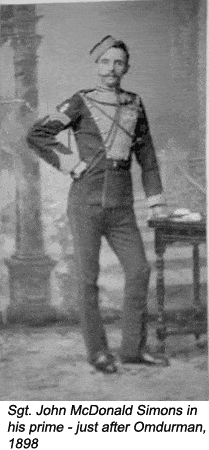
Like many other veterans of earlier wars and due to his previous military service in the cavalry, John was not sent overseas with the early Australian contingents but was posted to the Light Horse Training Squadron to teach new recruits. One of the many photos in his album shows John seated on his horse in AIF uniform, with five recruits in civilian clothes trotting past. Standing in the centre of the photo is an officer in AIF uniform. They were obviously assessing the riding capabilities of the prospective new Light Horse recruits.
Although he joined up as a private, his previous military service quickly resulted in him being promoted to Acting Sergeant, followed by Sergeant in July 1915. Another photo shows John seated with the Commanding Officer and NCO’s of the 1st Light Horse Regiment at Liverpool, Sydney in 1915.
John’s desire to leave for the front was finally rewarded when he boarded the troopship SS “Argylshire” at Sydney on 30th October 1915. The troops disembarked at Suez on 30th November 1915. These reinforcements arrived in the Middle East just in time to qualify for the 1914-15 Star but were too late to be sent on to Gallipoli.
The nine month Gallipoli campaign was coming to an end and during the night of 20th December 1915, the last Australian left the peninsular. The remaining members of the 1st Light Horse were evacuated to Mudros Island and were then sent back to a base camp at Heliopolis in Egypt, where they arrived on 26th December.
In January and February 1916 the regiment were engaged in patrols against the pro-Turkish Senussi tribes in the Suez Canal zone. In March 1916, John McDonald Simons was attached to the Australian Camel Transport Corps and was promoted to the rank of Acting Company QuarterMaster Sergeant.
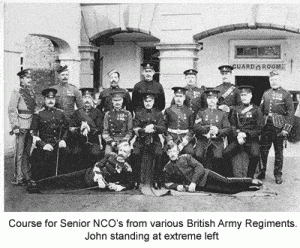 In May 1916 the 1st Light Horse moved across the canal into the Sinai desert, due to a Turkish threat in the area. By July 1916, General Harry Chauvel had moved up his Anzac Mounted Division and based them at Romani in the Sinai. (In early August there would be a fierce battle here and the name “Romani” was soon to become famous in Australian military history).
In May 1916 the 1st Light Horse moved across the canal into the Sinai desert, due to a Turkish threat in the area. By July 1916, General Harry Chauvel had moved up his Anzac Mounted Division and based them at Romani in the Sinai. (In early August there would be a fierce battle here and the name “Romani” was soon to become famous in Australian military history).
However, John’s advancing age together with his many years ‘in the saddle’ were beginning to tell and his stay in the Middle East was short lived. His records indicate that he was suffering rheumatism in the field and was admitted to hospital in July 1916. He returned to Australia on board the hospital ship “Seang Choon” on 17th July 1916. After a spell in hospital he was finally discharged from the 1st Light Horse as medically unfit on 3rd October 1916.
I am not aware of what profession he went back to when he left the army. John McDonald Simons continued to live in Sydney and passed away in suburban Manly on 19th April 1931, at the age of 61 years.
His medals, the first shilling he ever earnt and his wonderful and historic photo albums are all testimony to a man who served his Queen, King and country over many colourful years.
By: Dave George
References:
Churchill, Winston S – My Early Life.
Churchill, Winston S – The River War
Ziegler, Philip – Omdurman.
Australian Archives, Canberra.
Public Records Office, London.
Notes:
Very few Australians served at Omdurman. The only other man I know of was Major the Hon. H. Finn, who commanded ‘A’ Squadron, 21st Lancers. He was later Commandant of the Queensland Defence Force, 1900-1901.
John McDonald SIMONS – WW1
| Regimental number | 1268 |
| Religion | Church of England |
| Occupation | Caddy Master |
| Address | Wanie Street, North Manly, New South Wales |
| Marital status | Married |
| Age at embarkation | 42 |
| Next of kin | Wife, Mrs. Florence Simons, Wanie Street, North Manly, New South Wales |
| Enlistment date | 31 March 1915 |
| Rank on enlistment | Private |
| Unit name | 1st Light Horse Regiment, 9th Reinforcement |
| AWM Embarkation Roll number | 10/6/2 |
| Embarkation details | Unit embarked from Sydney, New South Wales, on board HMAT A8 Argyllshire on 30 September 1915 |
| Rank from Nominal Roll | Private |
| Unit from Nominal Roll | 1st Light Horse Regiment |
| Returned to Australia 17 July 1916 |
